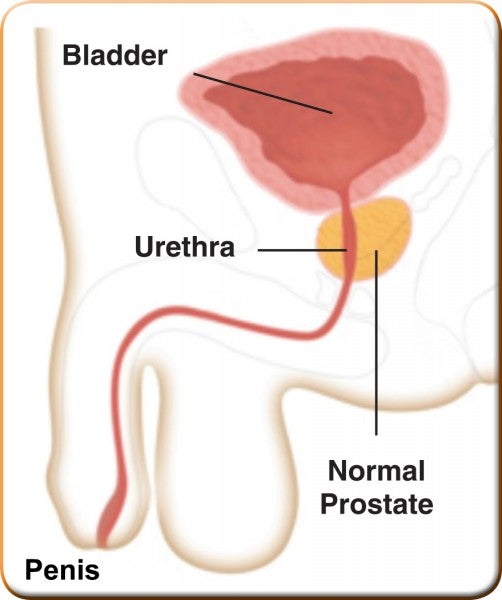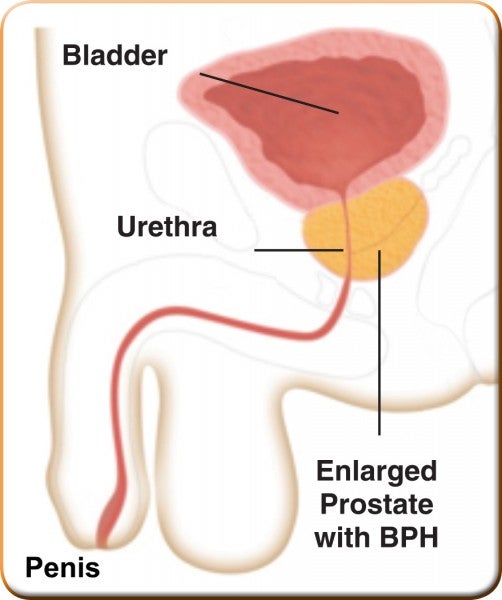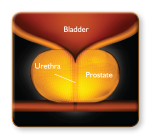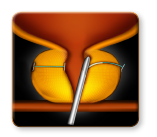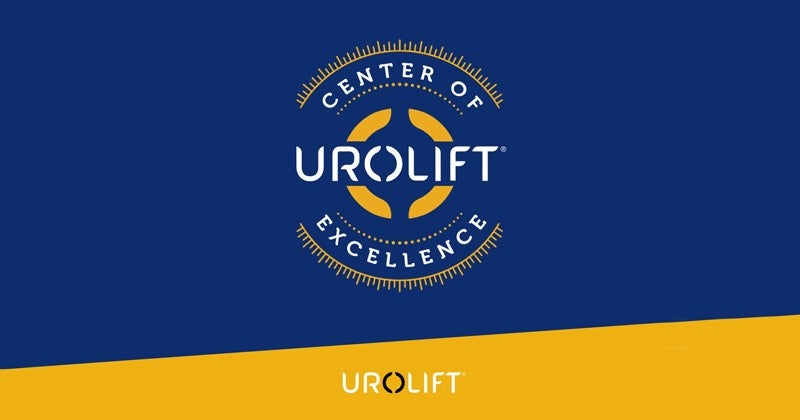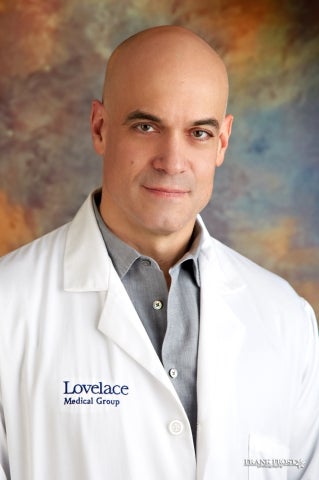Urology
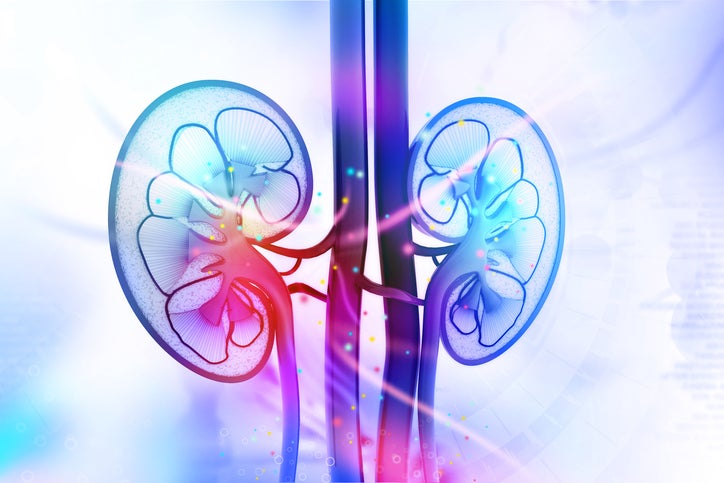
Overview
Expert urologists at Lovelace
At Lovelace Medical Group, our dedicated team of urologists is at the forefront of providing specialized care for a wide array of urological conditions. With a focus on compassionate, patient-centered treatment, we employ the latest advancements in medical technology to ensure you receive the best possible care.
Our comprehensive urological treatments
Our urology clinic is equipped to diagnose and treat a variety of urological conditions, including but not limited to:
Bladder and prostate care: Our specialists excel in managing conditions affecting bladder and prostate health, offering innovative treatments for incontinence, prostate enlargement, and cancer care.
Kidney stone management: Utilizing state-of-the-art techniques, we provide effective treatments for kidney stones, aiming for minimal discomfort and swift recovery.
Cancer treatments: We offer comprehensive care for cancers of the bladder, kidney, prostate, and testicular cancers, emphasizing early detection and personalized treatment plans.
Minimally invasive surgical options: Our use of the daVinci Surgical System exemplifies our commitment to less invasive surgical options, reducing recovery times and improving outcomes.
Urological conditions we treat
Using leading-edge technology and minimally invasive techniques whenever possible, our urologists provide high quality care for the following conditions:
- Bladder control problems (incontinence)
- Blood in the urine
- Cancer (bladder, kidney, prostate*, testicular, etc.)
- Erectile dysfunction & impotence
- Female pelvic outlet relaxation disorders
- Kidney dysfunction
- Kidney stones
- Prolapsed pelvic organ
- Prostate enlargement
- Chronic urinary tract infections
- Urinary tract stones
- Vasectomy
Advanced diagnostics and patient care
We believe in a proactive approach to urological health, offering advanced diagnostic tools and imaging services to screen for prostate problems. Our clinic is renowned for its expertise in managing urinary tract infections, male sterilization, and sexual health concerns. We prioritize your comfort and privacy, ensuring a respectful and understanding environment for all your health needs.
Why choose Lovelace’s urology clinic?
At Lovelace Medical Group, we are proud to offer high quality urological care to our patients in New Mexico. When you come to us for bladder and prostate care, you can expect:
- An expert team: Our urologists are leaders in their field, dedicated to delivering high-quality care. Innovative treatments: We stay at the cutting edge of urological treatments and technologies. Patient-centered care: Your health and comfort are our top priorities, guiding every decision we make. Comprehensive treatments: From initial consultation to post-treatment follow-up, we provide a seamless care experience.
Get in touch
If you're experiencing urological concerns, don't wait to seek help. Contact us today to schedule a consultation with our expert urologists and take the first step towards improved urological health. At Lovelace Medical Group, we're here to support you every step of the way.
Enlarged Prostate
Benign Prostatic Hyperplasia (BPH)
- What is BPH?
- BPH Treatment Options
- UroLift® System
- UroLift® System Frequently Asked Questions
- Rezum® Water Vapor Therpay
- GreenLight™ Laser Therapy
- Talking to Your Doctor About BPH
What is BPH?
Benign Prostatic Hyperplasia, or BPH, is a condition in which the prostate enlarges as men get older. Over 70% of men in their 60s have BPH symptoms so it is very common1. While BPH is a benign condition and unrelated to prostate cancer, it can greatly affect a man's quality of life.
The prostate is a male reproductive gland, about the size of a walnut, that produces fluid for semen. The prostate surrounds the urethra, which is the tube that carries urine from the bladder out of the body. As the prostate enlarges, it presses on and blocks the urethra, causing bothersome urinary symptoms such as:
- Frequent need to urinate both day and night
- Weak or slow urinary stream
- A sense that you cannot completely empty your bladder
- Difficulty or delay in starting urination
- Urgent feeling of needing to urinate
- A urinary stream that stops and starts
If you suffer from the above symptoms, you are not alone. BPH is one of the leading reasons for men to visit a urologist2.
Normal Prostate
|
Enlarged Prostate
|
- Berry, et al., Journal of Urology 1984
- IMS Health Urology 2013
© 2015 NeoTract, Inc. All Rights Reserved. MAC00181-01 Rev D
BPH Treatment Options
Watchful Waiting
If your BPH symptoms are mild to moderate and don’t interrupt your daily routine, your doctor may recommend a watch-and-wait approach. It includes active monitoring before considering other treatments.
Medications
Alpha blockers relax the muscles in the bladder and prostate, making it easier to urinate. And alpha reductase inhibitors help shrink the prostate gland by blocking hormones.
Supplements
Some men with BPH have found success with over-the-counter nutritional supplements such as saw palmetto, beta-sitosterol and pygeum to alleviate symptoms. It’s best to talk to your doctor before you begin any supplements.
Behavioral Modifications
You may be able to control BPH symptoms by making lifestyle changes such as following a diet rich in fruits and vegetables. Getting regular exercise. Maintaining a healthy weight. Reducing stress in your life. Limiting caffeine, alcohol and other beverages in the evening. And avoiding decongestants and antihistamines and other medications that can aggravate symptoms.1
UroLift® System Treatment
The UroLift® System treatment is a minimally invasive approach to treating BPH that lifts or holds the enlarged prostate tissue out of the way so it no longer blocks the urethra. There is no cutting, heating or removal of prostate tissue. Clinical data has shown that the UroLift System treatment is safe and effective in relieving lower urinary tract symptoms due to BPH without any impact to sexual function.
Learn more about how the UroLift System treatment works or visit our FAQ page for more information on the benefits, risks, and recovery.
Rezūm® Water Vapor Therpay
Non-surgical, outpatient therapy that uses the natural energy stored in water vapor to shrink excess prostate tissue. For more information, click here.
GreenLight™ Laser Therapy
This treatment uses a high-energy laser to rapidly heat and vaporize the excess prostate tissue, resulting in a larger channel for urine to pass through. Learn more here.
Laser
Laser Resection of the Prostate
TURP may be performed with a laser in procedures called photoselective vaporization of the prostate (PVP) or holmium laser enucleation (HOLEP). Laser therapy lessens the bleeding risks of traditional TURP. However, since prostate tissue is still removed, there can be tissue swelling and an uncomfortable healing time. Typically, a catheter has to be inserted into the bladder after the procedure.
Surgery
Transurethral Resection of the Prostate (TURP)
TURP is the most common surgery to treat BPH. During this procedure, patients undergo general anesthesia, and prostate tissue is removed. TURP is often considered the "gold standard" for long-term results.
After prostate tissue has been removed, the body needs time to heal. The remaining prostate tissue may actually swell and become inflamed before the desired shrinking effect occurs. Patients may suffer an uncomfortable recovery period that includes short-term problems
such as bleeding, infection, erectile dysfunction, and urinary incontinence. Patients have to
have a catheter that is attached to a urine bag inserted into their bladder for several days after the procedure.
Symptom relief may not occur immediately, but lasts for a long time in many patients once it does occur.
There can be long-term side effects after TURP such as dry orgasm (retrograde ejaculation), erectile dysfunction or incontinence (leaking of urine).
Prostatectomy
This is a surgical procedure in which a surgeon removes all or part of the prostate gland through small incision(s) in the lower abdomen.1 The procedure may or may not involve the use of a robot.
-
Carter HB. Prostate Disorders: The Johns Hopkins White Papers. Baltimore, MD: Johns Hopkins Medicine. 2010:1-24.
-
American Urological Association Education Research, Inc. American Urological Association Guideline: Management of Benign Prostatic Hyperplasia (BPH), Revised. 2010. Appendix 280, 283-5.
© 2015 NeoTract, Inc. All Rights Reserved. MAC00181-01 Rev D
UroLift® System
What is the UroLift System?
The UroLift® System treatment is a revolutionary, minimally invasive approach to treating an enlarged prostate, or BPH, that lifts or holds the enlarged prostate tissue out of the way so it no longer blocks the urethra. There is no cutting, heating or removal of prostate tissue.
Clinical data has shown that the UroLift System treatment is safe and effective in relieving lower urinary tract symptoms due to BPH without compromising sexual function1,4. The goal of the UroLift System treatment is to relieve symptoms so you can get back to your life and resume your daily activities.
Most common side effects are light blood in the urine, some pain or discomfort when urinating, some increased urge to go and discomfort in the pelvis that typically resolve within two to four weeks after the procedure.
Advantages of the UroLift System:
- Rapid symptom relief, better than reported for medications2
- Risk profile better than reported for surgical procedures such as TURP3
- Preservation of sexual function1
- Return to normal activity in days not months
- Increased quality of life
- No ongoing BPH medications
- 19 clinical study publications; 4 years published clinical data4
How the UroLift works:
The UroLift System treatment is a straightforward procedure that is performed by a urologist. The urologist places tiny implants to hold the prostate lobes apart, like open curtains on a window, to relieve compression on the urethra. This allows urine to flow normally again. The UroLift System treatment can be done in the physician’s office under local anesthesia. Typically, patients return home the same day without a catheter.2
|
|
Enlarged Prostate: An enlarged prostate compresses on the urethra, making it difficult for urine to flow. |
|
|
Step 1: The UroLift Device is placed through the obstructed urethra to access the enlarged prostate. |
|
|
Step 2: Small UroLift Implants are permanently placed to lift and hold the enlarged prostate tissues out of the way and increase the opening of the urethra. The permanent implants are delivered through a small needle that comes out of the UroLift delivery device and into the prostate. |
|
|
Step 3: The UroLift delivery device is removed, leaving an open urethra designed to provide symptom relief. |
UroLift® Videos
1 McVary J Sex Medicine 2014
2 Roehrborn J Urology 2013; 2003 AUA Guidelines
3 Sonksen J Urology 2016
4 Roehrborn Urology Clinics 2016
© 2015 NeoTract, Inc. All Rights Reserved. MAC00181-01 Rev D
UroLift® System Frequently Asked Questions
1. What is the UroLift® System?
The UroLift® System is a new minimally invasive treatment designed to treat lower urinary tract symptoms (LUTS) due to benign prostatic hyperplasia (BPH).
2. How does the UroLift System work?
The UroLift System consists of a delivery device and tiny permanent implants. FDA cleared in 2013, this unique technology works by directly opening the urethra with tiny implants that hold the enlarged tissue out of the way, like tiebacks on a window curtain. No cutting, heating, or ablating tissue is involved, making the UroLift System the first and only BPH treatment that does not remove prostate tissue and does not negatively impact a man’s sexual function.
3. How do I know if the UroLift System treatment is right for me?
The UroLift System is a proven treatment option for BPH patients who are looking for an alternative to drugs or major surgery. You may be considering or scheduled for a TURP/Laser treatment, or are unhappy with or have stopped taking medications. The UroLift System is appropriate for patients seeking a minimally invasive treatment and are concerned about preserving their sexual function and their quality of life.
4. What should I expect during the UroLift System treatment?
If you and your doctor decide that the UroLift System treatment is right for you, your doctor will provide the specific, detailed information relating to your condition. In general, the UroLift System is a minimally invasive treatment that entails minimal downtime. Your doctor will use the UroLift delivery device to deploy permanent implants to relieve obstruction caused by the enlarged prostate that is pressing on your urethra. The procedure may be performed under local or general anesthesia and you may be given medication to feel comfortable during the treatment. Typically, no catheter and no overnight stay is required post-treatment.
5. What happens post-treatment, during the recovery period?
After the treatment, almost all patients go home the same day without a catheter. There is minimal downtime post-treatment and many patients experience symptom relief in as early as 2 weeks. Patients may experience some urinary discomfort during the recovery period. The most common side effects may include light blood in the urine, some pain or discomfort when urinating, some increased urge to go and discomfort in the pelvis that typically resolve within two to four weeks after the procedure.
6. Will having the UroLift System treatment affect my sexual function?
Sexual function has been preserved among the hundreds of patients treated in our clinical studies.1,2,3,4 This is a unique benefit of the UroLift System treatment compared with other BPH therapies such as TURP, laser, and even medication.
7. Is the treatment permanent?
The UroLift Implant is a permanent implant, and the treatment is intended to be permanent. Durability has been shown to at least 4 years in U.S. clinical data,1 and results will continue to be published as follow-ups continue. One unique aspect of the UroLift System is that it does not preclude retreatment or other BPH treatments, should that be needed and desired in the future.
8. What happens if the implants need to be removed?
The implant is made up of standard surgical implantable materials: a nitinol capsular tab, a stainless steel urethral tab, and polyester suture that holds the two tabs together. Your doctor can simply remove the implant, if needed. The suture can be cut and the urethral endpiece can be retrieved with a standard grasper. The capsular tab will remain outside the prostate capsule in place.
9. Are there any contraindications?
The primary contraindications are an obstructive or protruding median lobe of the prostate and a prostate with a volume of >80cc.
10. Will the implants interfere with having an MRI?
Non-clinical testing has demonstrated that the UroLift Implant is MR Conditional. That means that you can be safely scanned in an MR system meeting the following conditions:
- Static magnetic field of 3 Tesla or less
- Maximum spatial gradient magnetic field of 1500 Gauss/cm (15 T/m) or less
- Maximum MR system reported, whole body averaged specific absorption rate (SAR) of 4 W/kg (First Level Controlled Mode)
Under the scan conditions defined above, the UroLift implant is expected to produce a maximum temperature rise of 2.4°C after 15 minutes of continuous scanning.
In non-clinical testing, the image artifact caused by the device extends approximately 15 mm from the UroLift Implant when imaged with a gradient echo pulse sequence and a 3 Tesla MRI system.
Patient implant cards are provided to inform the patient that the UroLift implant is MR Conditional and can safely be scanned only under specific MR conditions.
If you have any questions about MRI safety, please consult your doctor.
11. Will the UroLift implants affect a digital rectal exam (DRE)?
No. The implants are placed on the anterior (front) side of the prostate, and a DRE is conducted on the posterior (back) side of the prostate. The implants are not expected to interfere in a DRE.
12. What clinical data is available for the UroLift System?
Over 950 patient-years of clinical data has been presented in peer-reviewed publications to date demonstrating that the UroLift System is safe and effective. Clinical studies have been conducted in the United States, Canada, Europe and Australia.
13. How do I find out if my health plan covers the UroLift System treatment?
The first step is to make an appointment with your urologist to determine if you are an appropriate candidate for the treatment. Your physician’s office staff can work with you and your health plan to learn more about your healthcare benefits specific to the UroLift implant procedure.
14. Does Medicare cover the UroLift System?
Yes, all Medicare arriers provide benefits for the UroLift System when medically necessary. Discuss the UroLift System with your physician to determine if the UroLift treatment is an option for you.
15. Who performs the UroLift System treatment?
A urologist, a doctor who specializes in the treatment of diseases of the urinary system and sex organs, uses the UroLift System to treat urinary symptoms due to BPH. The urologist completes comprehensive training prior to using the UroLift System. Find a UroLift System doctor.
16. Where is the UroLift System available?
The UroLift System is available for sale in the United States, Europe, Canada and Australia.
17. Who manufactures the UroLift System?
NeoTract, Inc. manufactures the UroLift System. The company is based in Pleasanton, California.
- Roehrborn 2016 Urology Clinics
- Roehrborn, 2015 Canadian Journal of Urology, 3-Year Results L.I.F.T. Study
- Roehrborn, 2013 Journal of Urology, L.I.F.T Study
- McVary, 2014 Journal of Sexual Medicine, Preservation of sexual function with the prostatic urethral lift
© 2015 NeoTract, Inc. All Rights Reserved. MAC00181-01 Rev D
Rezūm Water Vapor Therapy
Rezūm Water Vapor Therapy is a natural alternative to surgery. It treats the cause of your BPH, so you can get back to your life. Do you have BPH?
What is Rezūm Water Vapor Therapy?
Rezūm Therapy treats the source of BPH — your enlarged prostate. This short, in-office procedure uses the natural energy stored in a few drops of water to shrink the prostate so urine can flow freely. There are no incisions, no general anesthesia, and most patients return to regular activities within a few days.* And, it preserves sexual function.1,2
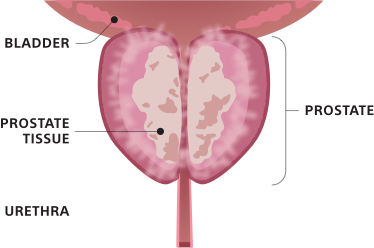
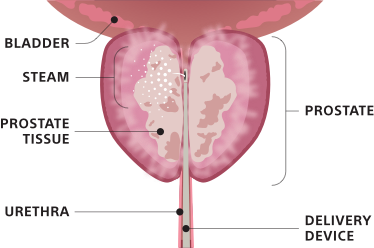
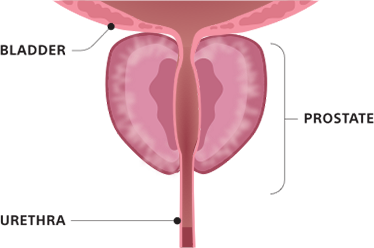
How does Rezūm Water Vapor Therapy work?
Rezūm Water Vapor Therapy is a non-surgical treatment that uses the natural energy stored in water vapor, or steam, to remove excess prostate tissue that is pressing on the urethra.
During each 9-second treatment, sterile water vapor is released throughout the targeted prostate tissue. When the steam contacts the prostate tissue, all the stored energy is released into the tissue. Your doctor will determine the amount of treatments you need, based on the size of your prostate.
Over time, your body’s natural healing response absorbs the treated tissue, shrinking the prostate. With the extra tissue removed, the urethra opens, reducing BPH symptoms.
Most patients begin to experience symptom relief in as soon as two weeks, and maximum benefit may occur within three months.1,2 Patient responses can and do vary.
Who may benefit from Rezūm Water Vapor Therapy?
Rezūm Therapy may be an option for those who have given up on watchful waiting and lifestyle changes, men who are dissatisfied with, have stopped or don’t want to start taking BPH medications, and men not interested in other minimally invasive or surgical BPH procedures.
Patient Testimonial
Why is Rezūm Water Vapor Therapy an important option?
For years, the primary options for treating BPH were through medications or invasive surgery. Rezūm Therapy is a natural, in-office therapy option for men who do not want to take medication or are dissatisfied with medication symptom relief and want to avoid invasive surgery or implants to treat their BPH.
Market research indicates that preserving sexual function is a priority for men when it comes to BPH treatments.3 Clinical studies show Rezūm Therapy treats the cause of BPH symptoms while preserving sexual function.1
Where is the Rezūm Water Vapor Therapy procedure performed?
Rezūm Therapy can be performed in a short visit at our office, clinic or another outpatient setting.
Is Rezūm Water Vapor Therapy covered by insurance?
Rezūm Therapy is considered a covered benefit by Medicare and most private insurance. Patients should verify their benefits with their insurance company in advance of the scheduled procedure.
How quickly do patients experience symptom relief?
Clinical studies show that most men experience symptom relief as soon as two weeks after treatment with Rezūm Therapy, and maximum benefit may occur within three months.4 As with any procedure, patient responses can vary.
How soon can patients return to regular activities?
Clinical studies show that following treatment with Rezūm Therapy, most men return to regular activities within a few days.2 Your provider will make personal recommendations on resuming activity.
Providers currently offering Rezūm at Lovelace Medical Group:
Make an appointment today with Dr. Geswaldo to see if Rezūm may be an option for you! Call 505.727.6200 or Schedule an appointment today
Additional Resources:
Click here to view the Rezūm patient brochure
Click here to view a Rezūm Patient FAQ Handout
Click here for the Rezūm/BPH Treatment Discussion Guide
For more information about BPH and Rezūm Water Vapor Therapy, please visit www.Rezum.com.
* Dependent on individual clinical situation and healing response.
1 1 McVary KT, Rogers T, Roehrborn CG. Rezūm water vapor thermal therapy for lower urinary tract symptoms associated with benign prostatic hyperplasia: 4-year results from randomized controlled study. Urology. 2019 Apr;126:171-9.
2 2 McVary KT, Gange SN, Gittelman MC et al. Minimally invasive prostate convective water vapor energy (WAVE) ablation: A multicenter, randomized, controlled study for the treatment of lower urinary tract symptoms secondary to benign prostatic hyperplasia. J Urol. 2016 May;195(5):1529-38.
GreenLight Laser Therapy
GreenLight Laser Therapy is a proven treatment that has helped more than 1 million men around the world gain relief from the frustrating and life-changing symptoms of BPH. Do you have BPH? Click here to take the quiz.
What is GreenLight Laser Therapy?
GreenLight Laser Therapy uses a laser to remove excess prostate tissue. The laser treatment is delivered through a thin, flexible fiber, which is inserted into the urethra through an instrument called a cystoscope.
How does GreenLight Laser Therapy work?
A small fiber is inserted into the urethra through a cystoscope. The fiber carries laser energy that quickly removes prostate tissue. The tissue removal will allow urine to pass through freely. Natural urine flow is rapidly restored, and urinary symptoms are quickly relieved in most patients.
Do I have to stay in the hospital after a GreenLight procedure?
GreenLight Laser Therapy is generally an outpatient procedure. Typically, no overnight stay in the hospital is required, but it will depend on your individual condition.
What are the risks of GreenLight Laser Therapy?
All surgical treatments have inherent and associated risks. The GreenLight Laser System is intended for removal of soft tissue, including vaporization of the prostate for benign prostatic hyperplasia (BPH). Potential risks include irritative symptoms, bleeding, retrograde ejaculation and urinary tract infection.
How long does it take until symptoms are relieved?
Most patients experience relief of symptoms and improvement in urine flow within 24 hours of the procedure. However, medical history, your health conditions and other factors can influence treatment and recovery.1
How soon can I return to work or normal activity?
Most patients can resume normal activities within a couple of days. Strenuous activities can be resumed within a short time.1 Your doctor will discuss any restrictions and your specific condition during your visit following your procedure.
Does the GreenLight procedure affect sexual function?
In a recent study, 86% of patients reported improved or unchanged sexual satisfaction; 14% worsened. Similar outcomes were seen for erectile function.2
Is GreenLight Laser Therapy covered by insurance?
Medicare and most private insurers cover the GreenLight Laser Therapy procedure. It is the responsibility of the patient to contact their insurance provider for specific coverage information.
How do I know if I am a candidate for GreenLight Laser Therapy?
The GreenLight procedure is generally appropriate for most symptomatic BPH patients. Your provider will assess your symptoms and desired outcomes and determine the best course of treatment for you.
Watch: GreenLight Laser Therapy Patient Education Video
Providers currently offering GreenLight at Lovelace Medical Group:
- Aaron Geswaldo, D.O. (designated as a GreenLight Center of Excellence)
Make an appointment today with Dr. Geswaldo to see if GreenLight Laser Therapy may be an option for you! Call 505.727.6200 or schedule an appointment today
Additional Resources:
For more information on BPH and GreenLight Laser Therapy, please visit www.TreatMyBPH.com.
1 1. Bachmann A, Tubaro A, Barber N, et al.180-W XPS GreenLight Laser Vaporisation Versus Transurethral Resection of the Prostate for the Treatment of Benign Prostatic Obstruction: 6 Month Safety and Efficacy Results of a European Multi-Centre Randomised Trial - The GOLIATH Study. Euro Urol. May 2014; 65(5): 931-942.
2 2. Lukacs B, Loeffler J, Bruyère F, et al. Photoselective vaporization of the prostate with GreenLight 120-W laser compared with monopolar transurethral resection of the prostate: A multicenter randomized controlled trial. Eur Urol. 2012;61(6):1165-73.
Talking to Your Doctor About BPH
BPH is a very common condition and is one of the leading reasons for men to visit a urologist. Whether you have just started experiencing symptoms or if you've tried various medications or even surgery, there are a range of treatment options available.
Before you visit the doctor's office, you can take this BPH Symptom Quiz, designed by the American Urological Association, to determine the severity of your symptoms. We will discuss your symptoms together to decide which treatment option is best for you.
Schedule an appointment today to discuss your BPH symptoms with us.
© 2015 NeoTract, Inc. All Rights Reserved. MAC00181-01 Rev D
Providers
Click on a provider to view more information




